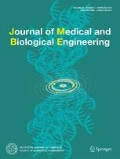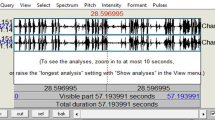Abstract
This study developed a speech recognition technique to detect wheezing. Wheezes are important in the diagnosis of pulmonary pathologies such as asthma. The acoustic features of wheezes are distinct in the frequency domain. Therefore, many studies have focused on detecting wheezing peaks in spectrograms through image processing. However, automated detection of wheezing peaks is difficult because of blurred edges and noise. This paper proposes an alternative approach for wheezing detection in which the mel frequency cepstral coefficients (MFCCs) are integrated into the Gaussian mixture model (GMM). The MFCCs reduce the short-term spectral information to a few coefficients, and the GMM recognizes the respiratory sounds. The respiratory sounds of 18 volunteers (9 asthmatic and 9 normal adults) were recorded for training and testing. The results of a qualitative analysis of wheeze recognition showed a good sensitivity of 0.881 and a high specificity of 0.995.










Similar content being viewed by others
References
Sovijarvi, A. R. A., Vanderschoot, J., & Earis, J. E. (2000). Standardization of computerized respiratory sound analysis. European Respiratory Review, 10, 585–649.
Sovijarvi, A. R. A., Malmberg, L. P., Charbonneau, G., Vanderschoot, J., Dalmasso, F., Sacco, C., et al. (2000). Characteristics of breath sounds and adventitious respiratory sounds. European Respiratory Review, 10, 591–596.
Fiz, J. A., Jane, R., Izquierdo, J., Homs, A., Garcia, M. A., Gomez, R., et al. (2005). Analysis of forced wheezes in asthma patients. Clinical Investigations, Clinical Investigations, 73, 55–60.
Shabtai-Musih, Y., Grotberg, J. B., & Gavriely, N. (1992). Spectral content of forced expiratory wheezes during air, He, and SF6 breathing in normal humans. Journal of Applied Physiology, 72, 629–635.
Fenton, T. R., Pasterkamp, H., Tal, A., & Chernick, V. (1985). Automated spectral characterization of wheezing in asthmatic children. IEEE Transaction on Biomedical Engineering, 32(1), 50–55.
Waris, M., Helisto, P., Haltsonen, Saarinen, Saarinen, A., & Sovijarvi, A. R. (1998). A new method for automatic wheeze detection. Technology and Health, 6, 33–40.
Homs-Corbera, A., Fiz, J. A., Morera, A., & Jane, R. (2004). Time-frequency detection and analysis of wheezes during forced exhalation. IEEE Transaction on Biomedical Engineering, 51, 182–186.
Lin, B. S., Lin, B. S., Wu, H. D., Chong, F. C., & Chen, S. J. (2006). Wheeze recognition based on 2D bilateral filtering of spectrogram. Biomedical Engineering Applications, Basis & Communications, 18, 128–137.
Taplidou, S. A., & Hadjileontiadis, L. J. (2010). Analysis of wheezes using wavelet higher order spectral features. IEEE Transactions on Biomedical Engineering, 57(7), 1596–1610.
Jin, F., Krishnan, S., & Sattar, F. (2011). Adventitious sounds identification and extraction using temporal–spectral dominance-based features. IEEE Transactions on Biomedical Engineering, 58(11), 1596–1610.
Uwaoma, C., & Mansingh, G. (2014). Detection and classification of abnormal respiratory sounds on a resource-constraint mobile device. International Journal of Applied Information Systems, 7(11), 35–40.
Kwan, A. M., Fung, A. G., Jansen, P. A., Schivo, M., Kenyon, N. J., Delplanque, J. P., et al. (2015). Personal lung function monitoring devices. IEEE Sensors Journal, 15(4), 2238–2247.
Bahoura, M. (2009). Pattern recognition methods applied to respiratory sounds classification into normal and wheeze classes. Computers in Biology and Medicine, 39, 824–843.
Batra, K., Bhasin, S., & Singh, A. (2012). Acoustic analysis of voice samples to differentiate healthy and asthmatic persons. International Journal of Engineering and Computer Science, 4(7), 13161–13164.
Reynolds, D. A., & Rose, R. C. (1995). Robust text-independent speaker identification using Gaussian mixture speaker models. IEEE Transactions on Speech and Audio Processing, 3(1), 72–82.
Vergin, R., O’Shaughnessy, D., & Farhat, A. (1999). Generalized mel frequency cepstral coefficients for large-vocabulary speaker-independent continuous-speech recognition. IEEE Transactions on Speech and Audio Processing, 7(5), 525–532.
Polur, P. D., & Miller, G. E. (2005). Experiments with fast Fourier transform, linear predictive and cepstral coefficients in dysarthric speech recognition algorithms using hidden Markov model. IEEE Transactions on Neural Systems and Rehabilitation Engineering, 13(4), 558–561.
Ruinskiy, D., & Lavner, Y. (2007). An effective algorithm for automatic detection and exact demarcation of breath sounds in speech and song signals. IEEE Transactions on Audio, Speech and Language Processing, 15(3), 838–850.
Woojay, J., & Juang, B. H. (2007). Speech analysis in a model of the central auditory system. IEEE Transactions on Audio, Speech and Language Processing, 15(6), 1802–1817.
Chen, W. H., Chiu, Y. H., Wang, H. C., Hung, Y. W., Su, H. P., & Cheng, K. S. (2014). Tracheal opening discrimination during intubation using acoustic features and Gaussian mixture model. Journal of Medical and Biological Engineering, 34(6), 605–611.
Wodicka, G. R., Stevens, K. N., Golub, H. L., Cravalho, E. G., & Shannon, D. C. (1989). A model of acoustic transmission in the respiratory system. IEEE Transaction on Biomedical Engineering, 36(9), 925–934.
Stevens, S. S., & Volkman, J. (1937). A scale for the measurement of the psychological magnitude pitch. Journal of the Acoustical Society of America, 8, 185–190.
Dempster, A. P., Laird, N. M., & Rubin, D. B. (1977). Maximum likelihood from incomplete data via the EM algorithm. Journal of the Royal Statistical Society: Series B, 39, 1–38.
Acknowledgments
This research was partly supported by Ministry of Science and Technology in Taiwan (R.O.C.), under grants MOST 103-2218-E-305-001, MOST 103-2218-E-305-003, and MOST 104-2221-E-305-006.
Author information
Authors and Affiliations
Corresponding author
Rights and permissions
About this article
Cite this article
Lin, BS., Lin, BS. Automatic Wheezing Detection Using Speech Recognition Technique. J. Med. Biol. Eng. 36, 545–554 (2016). https://doi.org/10.1007/s40846-016-0161-9
Received:
Accepted:
Published:
Issue Date:
DOI: https://doi.org/10.1007/s40846-016-0161-9




